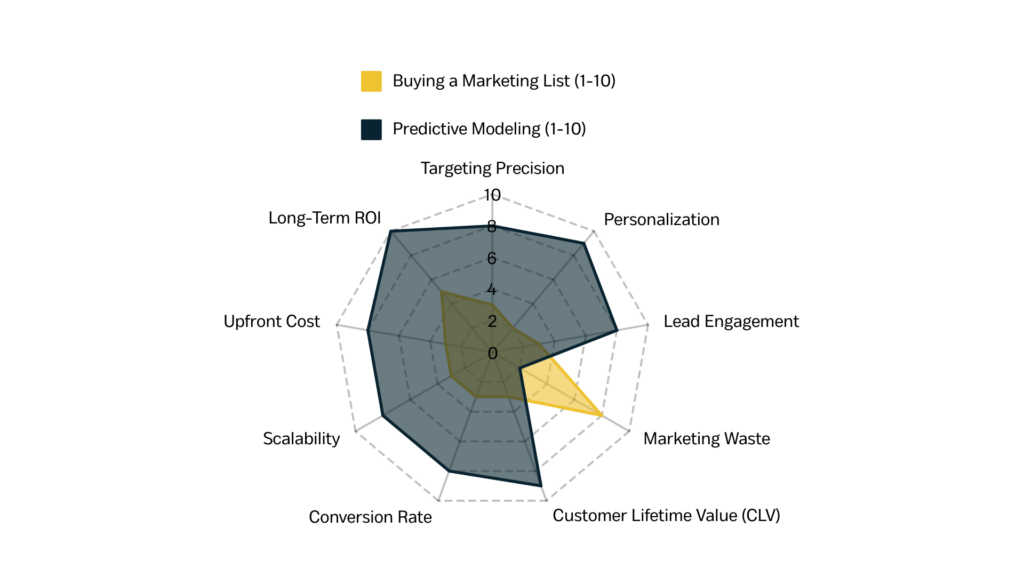Why Predictive Modeling Outperforms Buying Marketing Lists: The Key to Superior Customer Targeting and Personalization
When it comes to marketing, few decisions impact the success of a campaign more than your approach to acquiring leads. Historically, businesses looking to boost their customer base or target new markets have leaned on buying marketing lists. These lists—names and contact information of potential customers—can be acquired relatively cheaply and quickly. However, the alternative of building lookalikes through machine learning (ML) and predictive modeling is becoming increasingly popular.
With data quality estimated to impact marketing outcomes by over 40%, predictive modeling has become the go-to approach for marketers. looking to optimize campaign performance. This approach delivers value across key areas such as targeting precision, personalization, marketing ROI, and long-term customer relationships.
Understanding the Basics: Buying a List vs. Predictive Modeling
Buying a Marketing List
Buying a marketing list is a traditional, volume-based approach. It involves purchasing a large database of contacts, which can be filtered by certain demographic markers like age, location, income, or occupation. The goal is to mass-market to as many people as possible in the hope of finding a fraction of individuals who are interested in your product or service.
Advantages:
- Quick access to thousands of contacts.
- Low upfront costs.
Disadvantages:
- Low quality and engagement rates.
- High marketing waste (unopened emails, junked mail, unqualified leads).
- Lack of personalization and customer insights.
Predictive Modeling with Machine Learning
Predictive modeling takes a more sophisticated approach. By using machine learning algorithms to analyze existing customer data, businesses can build predictive models that identify lookalike audiences—people who share similar behaviors, preferences, and characteristics to your current best customers. The models predict which leads are most likely to engage, purchase, and remain loyal.
Advantages:
- High-quality, engaged prospects.
- Better targeting based on behaviors and preferences.
- Highly personalized messaging and campaigns.
- Reduced marketing waste.
Disadvantages: - Higher upfront cost.
- Requires investment in data infrastructure and skilled personnel.
Models built by Boostt.ai with your first-party data and its rich privacy-first third-party datasets power precision in mass marketing to drive significantly higher customer acquisition value than generic marketing lists.
Why Predictive Modeling Delivers Superior Results
Better Targeting Precision
- Buying a List: When you buy a marketing list, you’re playing a numbers game. You’ll likely reach people who are not interested or who don’t match your ideal customer profile. This results in a high volume of unqualified leads.
- Predictive Modeling: Predictive modeling, by contrast, identifies individuals who are more likely to convert. It leverages third-party data and your customer’s historical data, such as purchasing behavior, to find potential customers who share critical traits with your best-performing existing customers. This level of precision means you’re not just casting a wide net—you’re fishing in a well-stocked pond.
Enhanced Personalization
- Buying a List: Generic, one-size-fits-all messaging is often the default with purchased lists. Since you lack detailed knowledge about the people you’re targeting, creating personalized marketing content is next to impossible. This leads to a poor customer experience.
- Predictive Modeling: Machine learning in marketing allows you to dive deep into individual preferences and behaviors and assign personas. You can segment your audience based on nuanced characteristics like their browsing history, purchase frequency, or engagement with past campaigns. With predictive models that assign personas, personalized recommendations and targeted offers are sent to prospects, improving their experience and increasing the likelihood of conversion.
Reduced Marketing Waste
- Buying a List: While you can send campaigns to a large number of contacts, only a small fraction may engage with your messaging. This results in significant marketing waste, which can erode your ROI over time. Spray and pray with marketing lists has a real cost in wasted advertising spend.
- Predictive Modeling: By targeting individuals who are more likely to respond to your offer, predictive modeling minimizes waste. Your campaigns reach only those who have a higher likelihood of converting, leading to more efficient use of your marketing budget.
Long-Term Value and Loyalty
- Buying a List: The impersonal nature of a purchased list doesn’t foster long-term relationships. Even if you manage to make an initial sale, building customer loyalty is challenging without deeper engagement.
- Predictive Modeling: Predictive modeling doesn’t just identify one-time buyers—it finds customers who are likely to stick around. By targeting lookalikes of your most loyal and high-value customers, you’re not only increasing initial conversion rates but also setting the foundation for long-term customer relationships.
The Compounded Benefits of Predictive Modeling
- Higher Conversion Rates: Targeted campaigns drive more conversions because you’re reaching people who are primed to buy.
- Increased Customer Lifetime Value: By focusing on lookalikes of your best customers, you’re not only acquiring leads, but you’re acquiring high-value leads that are likely to stay with you.
- Lower Acquisition Costs Over Time: While predictive modeling may cost more upfront, its ability to target high-quality leads means you spend less per acquisition in the long run.
- Scalability: Predictive models get smarter with more data. As your customer base grows, your predictive models become more refined, making future campaigns even more successful.
- Enhanced Brand Reputation: Personalized, relevant outreach improves customer experience, which in turn enhances your brand’s reputation and loyalty. Satisfied customers are more likely to refer others, adding to your organic growth.
Value Map For Each Approach

There are some tangible benefits to predictive prospecting:

Identifying Audience Traits that Truly Matter
Another critical distinction between buying a marketing list and using predictive modeling is the depth of audience insights.
Buying a List: High-Level Demographics
When you purchase a marketing list, the data typically includes surface-level demographics such as age, gender, income, location, or occupation. While these factors provide a general sense of your audience, they don’t capture the behaviors, motivations, or specific preferences that drive purchasing decisions. As a result, the leads generated through purchased lists often lack the deeper context needed for highly effective targeting, and broad demographic profiles often miss the nuances that differentiate a ready buyer from someone uninterested in your offer.
Predictive Modeling: Digging Deeper into What Drives Your Audience
Predictive modeling goes far beyond high-level demographics. By analyzing actual customer behavior—like browsing history, purchasing patterns, engagement with previous marketing campaigns, and even social media interactions—machine learning identifies the traits that truly matter in driving conversions. These can include:
- Behavioral Patterns: What products customers tend to buy, how frequently they make purchases, and their typical buying cycles.
- Psychographic Insights: Their interests, values, and attitudes that may influence purchasing decisions.
- Engagement Levels: How they interact with your brand across channels (email, website, social media, etc.), and their likelihood to engage with future campaigns.
The ability to pinpoint these more granular traits allows businesses to craft hyper-targeted marketing campaigns, resulting in messaging that resonates more deeply with the audience. For example, instead of marketing to a generic group of 25-34 year olds, you can target individuals who have previously shown interest in a product like yours, have a high likelihood of repeat purchases, and are ready to buy based on their behavioral cues. This behavioral targeting drives higher conversion rates.
Better Audience Segmentation
The rich insights from predictive modeling enable you to create precise segments within your target audience. Rather than relying on broad demographics, predictive models segment your audience based on the factors that are most likely to impact purchase decisions. This not only improves your targeting but also enhances your ability to personalize messaging, ultimately driving better engagement and stronger customer loyalty.
Depth of Insights for Each Approach
| Insights Available | Buying a Marketing List | Predictive Modeling |
|---|---|---|
| Demographic Data | High-level (age, gender, etc.) | Detailed |
| Behavioral Insights | Minimal | In-depth (browsing, purchase) |
| Psychographic Traits | None | Identifies interests, values |
| Engagement Level | None | Tracks and predicts engagement |
| Audience Segmentation | Broad, based on demographics | Detailed, based on behavior and traits |
By leveraging the specific audience traits that actually drive conversions, predictive modeling doesn’t just give you access to leads—it allows you to identify and engage the right leads. This deeper, behavior-driven understanding of your audience is what sets predictive modeling apart, making it a far more powerful tool than simply buying a list of names based on superficial demographic characteristics.
This refined focus on behavior and preferences enhances both the efficiency of your marketing spend and the overall customer experience, delivering results that far outpace the limitations of traditional demographic-based targeting.
Predictive Modeling as a Smart Investment
In today’s competitive landscape, efficient marketing is more important than ever. While buying a marketing list may seem like a quick and cheap way to access leads, its limitations in precision, personalization, and long-term ROI make it an inferior option. Predictive modeling, while requiring a higher initial investment, offers superior targeting, higher-quality leads, and a vastly improved customer experience, which ultimately translates into better results.
By investing in predictive modeling, you’re not just paying for leads—you’re paying for performance, personalization, and the long-term health of your customer relationships. The lasting value and significantly reduced marketing waste make it a smart choice for businesses aiming to grow efficiently and sustainably.
Contact us to see how machine learning can transform your customer targeting.



